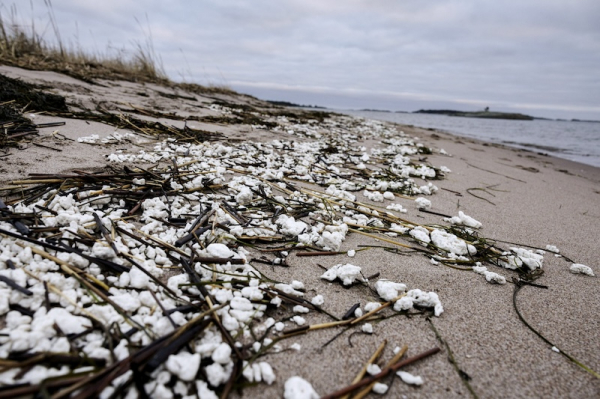
An unknown white substance on the shore of Vedagrundet in Hanko on 27 January 2025. LEHTIKUVA
- Previous Article Finland’s forests now emit more CO2 than they absorb
- Next Article HS: Finnish government mulls scrapping inheritance tax – economists wary
Large numbers of dead fish have washed ashore in Hanko, coinciding with the appearance of an unidentified white substance along a 20-kilometre stretch of coastline. Authorities are investigating possible links between the two incidents.
The dead fish, mostly herring and sprat, were first reported on Tuesday in areas around Hanko’s winter swimming facility and Regattaranta beach.
The city has since closed the swimming facility and advised against swimming in affected waters.
The Finnish Food Authority is analysing fish samples to determine the cause of death, including the possibility of poisoning. The Finnish Environment Institute (Syke) is conducting laboratory tests on the white, waxy material found on the beaches. Preliminary findings suggest it may be a fatty ester-like substance, which is mildly harmful but not immediately dangerous to humans.
One theory under investigation is that the substance originated from a ship. Experts from the John Nurminen Foundation believe the material could be residue from a cargo tank wash that was not properly cleaned in port. If confirmed, this would be a violation of international maritime regulations.
Syke researcher Sanna Suikkanen noted that paraffin-like substances occasionally wash up on shores worldwide. However, the scale of the incident in Hanko is unusual.
“The substance was likely transported in liquid form and solidified in the cold seawater before reaching the shore,” Suikkanen told Ilta-Sanomat.
Authorities have not yet determined whether the substance is linked to the mass fish deaths.
Emergency services, the city of Hanko, and the WWF have launched a clean-up operation. Volunteers have been asked to sign up through the WWF website to assist with removing the substance from beaches.
Hanko residents had already begun clearing the material before the official response was organised. Marke Kettunen, who was among the first to start collecting the waxy substance, said local people feel a strong responsibility to protect their coastline.
“The beaches in Hanko are unique. We have to keep them clean,” Kettunen said.
Rescue services are also surveying nearby islands and waters to assess the extent of the contamination. The public has been advised to avoid direct contact with the substance and dead fish until the laboratory results are available.
HT
- Previous Article Finland’s forests now emit more CO2 than they absorb
- Next Article HS: Finnish government mulls scrapping inheritance tax – economists wary
Source: www.helsinkitimes.fi
